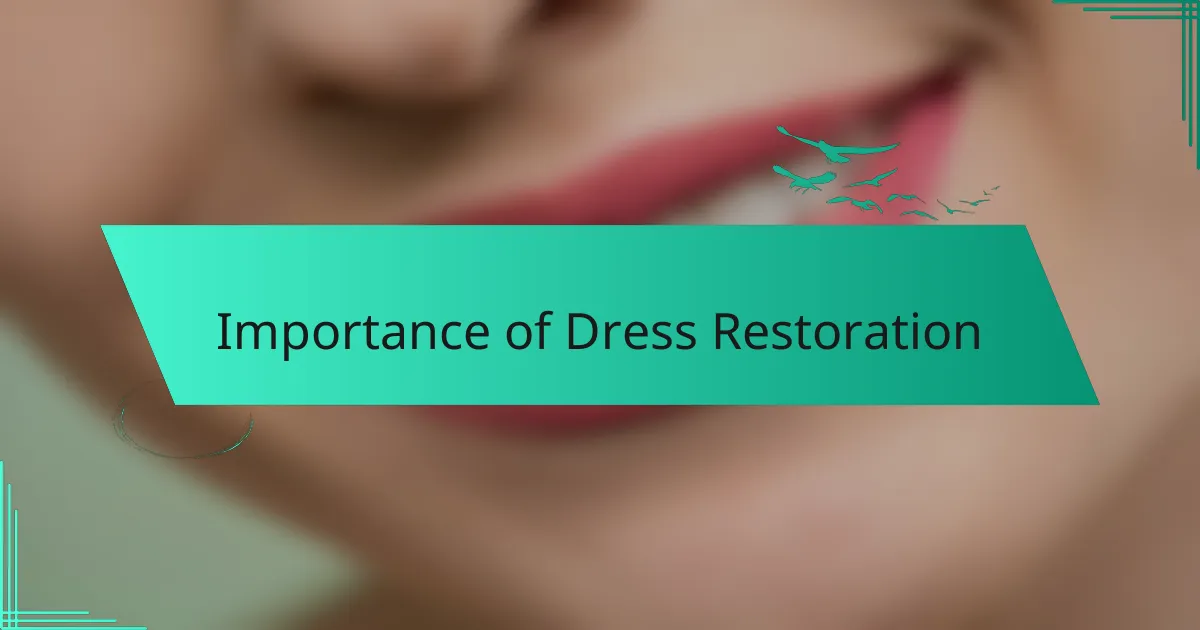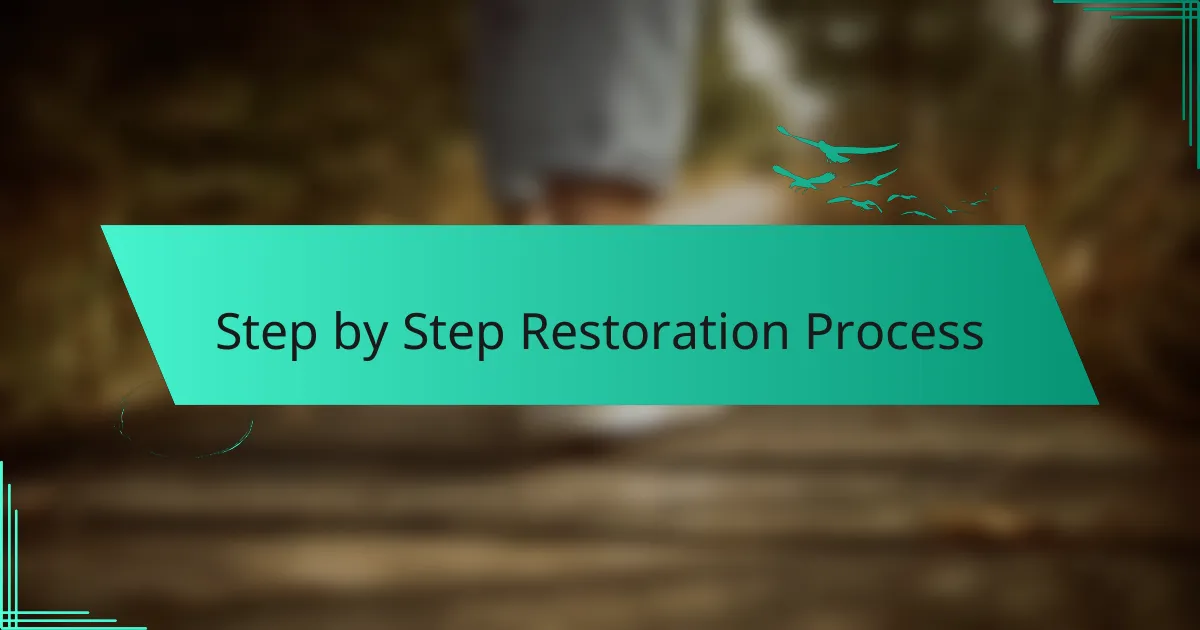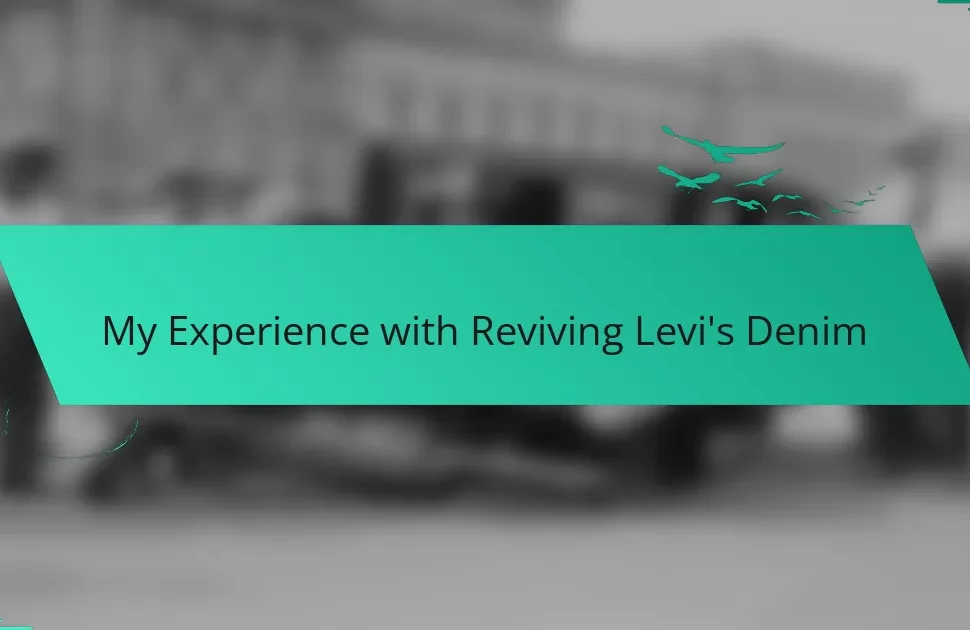Key takeaways
- Vintage fashion offers a unique blend of style, sustainability, and historical significance, promoting individuality over fast fashion.
- Restoration of vintage garments not only revitalizes fabric but preserves their stories, allowing future generations to connect with the past.
- Essential tools for restoration include sewing machines, hand sewing needles, and fabric glue, emphasizing careful handling and expertise.
- Proper care for vintage clothing involves gentle cleaning, correct storage, and regular inspections to maintain their beauty and integrity.

Introduction to Vintage Fashion
Vintage fashion possesses a unique charm that transcends time. I remember the first time I stumbled upon a beautifully preserved garment from the 1950s. Holding it in my hands, I felt a connection to a bygone era—each stitch an echo of history. This sense of nostalgia is part of what draws so many of us to vintage pieces; they tell stories that modern clothing often lacks.
Moreover, the allure of vintage fashion goes beyond aesthetics. It’s about sustainability and individuality in a world flooded with fast fashion. When I decided to restore my 1950s Dior dress, it wasn’t just about preserving a piece of art; it was about bringing new life to something that had already captivated hearts decades ago. Here are some reasons why vintage fashion continues to inspire:
- Unique Style: Each piece has its own character—nothing beats the individuality of vintage garments.
- Sustainable Choice: Choosing vintage helps reduce waste and promotes eco-friendly fashion practices.
- Historical Significance: Every item carries a story, connecting us to the past.
- Quality Craftsmanship: Vintage pieces often showcase quality tailoring and materials that are hard to find in today’s mass-produced fashion.
- Community Connection: Engaging in vintage fashion often means connecting with others who share a passion for history and style.

Importance of Dress Restoration
Restoring a vintage dress is much more than simply mending fabric; it’s about revitalizing history. I still remember the first time I carefully repaired a seam on my Dior dress—each stitch felt like a bridge connecting me to the past. How often do we get the chance to conserve something that showcases a unique blend of artistry and craftsmanship from an era long gone? By restoring these garments, we safeguard their stories for future generations.
Not only does restoration breathe new life into worn-out pieces, but it also fosters a deep appreciation for the artistry involved in their creation. The process of refurbishment invites us to learn and reflect on the values that drove fashion in the past. I found myself captivated by the intricate details of my dress, which reminded me that fashion is not just about clothing; it’s about culture and identity. Isn’t it fascinating how a simple dress can encapsulate the spirit of a decade?
Furthermore, by undertaking dress restoration, we empower ourselves to be part of a sustainable movement. Each time I reclaim a piece of vintage fashion, I feel a sense of pride for contributing to a more eco-conscious future. It’s like each restoration is a little rebellion against the throwaway culture we often find ourselves in today. Wouldn’t you agree that reviving a vintage piece adds a personal touch that mass-produced items simply can’t replicate?

Tools Needed for Restoration
Restoring a 1950s Dior dress is both a thrilling and delicate process. Having worked on several vintage pieces, I’ve found that the right tools make all the difference. Each tool serves a unique purpose, from ensuring that the fabric is treated gently to achieving those pristine finishes that characterize haute couture.
Here’s a list of essential tools I used in my restoration project:
- Sewing Machine: A reliable sewing machine, ideally one with adjustable settings, to handle various fabrics.
- Hand Sewing Needles: Different sizes for detailed work and delicate repairs.
- Thread: Color-matched thread to maintain the dress’s original charm.
- Fabric Scissors: Sharp scissors are critical for clean cuts without fraying.
- Iron and Ironing Board: For pressing seams and removing creases, giving the dress a fresh look.
- Fabric Glue: Useful for quick fixes on delicate embellishments.
- Tape Measure: To ensure accurate measurements during alterations.
- Seam Ripper: For gentle removal of stitches without damaging the fabric.
- Protective Gloves: To prevent oils from my hands getting on the vintage fabric.
When I first pulled out my trusty sewing tools, a wave of nostalgia hit me. It took me back to learning sewing from my grandmother, who always emphasized the importance of using the right tools. These memories made the restoration process not just a project, but a heartfelt tribute to the elegance of the past.

Step-by-Step Restoration Process
Restoring a 1950s Dior dress is truly a labor of love. I remember holding the delicate fabric in my hands, imagining the stories it held. The process requires careful attention and a bit of patience, which I found to be a therapeutic escape from the rush of modern life.
Here’s a step-by-step overview of my restoration journey:
- Assess the Condition: I carefully examined the dress for stains, tears, and fabric wear. This preliminary step helped me prioritize what needed immediate attention.
- Gently Clean: Using a mild detergent, I hand-washed the fabric. It was exhilarating to see the original colors come to life again.
- Repair: Any tears were lovingly stitched up using a needle and thread that matched the vintage fabric. I felt a sense of accomplishment with each repair.
- Press and Restore Shape: After drying, I gently steamed the dress to restore its beautiful silhouette, taking care not to damage any delicate embellishments.
- Final Touches: I added a fresh lining where necessary and even accessorized it with a classic vintage belt, celebrating not just the dress but the era it embodies.
Each step was a journey through time, and I truly savored every moment.

Personal Journey with Dior Dress
Restoring my 1950s Dior dress felt like embarking on a heartfelt journey. I vividly remember the moment I first unfurled the fabric; there was something magical about seeing its intricate details up close. It reminded me of stories my grandmother used to tell about how fashion was an expression of identity back then. How could I not feel connected to that legacy?
As I worked on the dress, I sometimes hesitated, questioning whether I could truly do justice to such a masterpiece. Those moments of doubt were frequent, especially when I encountered worn areas that needed delicate repairs. Yet, each stitch I made was infused with care and respect, creating a bridge between eras. I realized that this process wasn’t merely about restoration; it was about honoring the craftsmanship and history that the dress carried.
One of the most poignant aspects of this journey was discovering how the dress resonated with me on a personal level. Each alteration became a reflection of my own growth and appreciation for the artistry involved in vintage fashion. Wasn’t it fascinating to think that a simple dress could evoke such powerful emotions? With every step, I found myself not just reviving a piece of clothing, but also celebrating the women who wore it before me.

Tips for Vintage Care
Taking care of vintage clothing requires a gentle touch and an understanding of the materials used back in the day. When I first started caring for my Dior dress, I learned the hard way that not all fabrics can handle modern cleaning methods. Instead of tossing it in the washing machine, I hand-washed it with a mild detergent, treating it like the delicate treasure it is. Have you ever felt a gentle fabric slip through your fingers, and realized just how precious it truly is?
Another key aspect of vintage care is proper storage. I’ve discovered that hanging my dress on a wooden hanger prevents unwanted creases while maintaining its shape. Using breathable garment bags is essential because synthetic materials can trap moisture, leading to mold. I once stored a vintage piece in plastic and learned my lesson the hard way. Seeing mildew spots on a cherished garment was heartbreaking. Isn’t it amazing how a little bit of knowledge can go a long way in preserving the beauty of these timeless pieces?
Lastly, I always recommend periodic inspections. Just like people, vintage garments can have their ups and downs. I often take the time to check seams and fabric every few months, even if I haven’t worn the dress. Catching small issues early can be a simple fix, preventing deeper damage down the road. It’s about nurturing the relationship I have with these pieces—not merely owning them but being an active participant in their story. How often do we take the time to cherish memories while ensuring they remain vibrant and intact?




